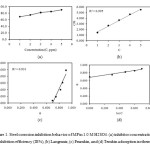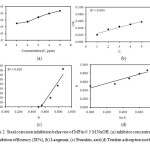Monikandon Sukumaran1*and Kesavan Devarayan2,
1Department of Basic Engineering, College of Fisheries Engineering, Tamil Nadu Fisheries University, Nagapattinam 611 001, Tamil Nadu, India.
2Department of Basic Sciences, College of Fisheries Engineering, Tamil Nadu Fisheries University, Nagapattinam 611 001, Tamil Nadu, India.
Corresponding Author E-mail: dev.kesavan@gmail.com
DOI : http://dx.doi.org/10.13005/msri/130206
Article Publishing History
Article Received on : 15 Oct 2016
Article Accepted on : 03 Nove 2016
Article Published :
Plagiarism Check: Yes
Article Metrics
ABSTRACT:
Steel corrosion inhibition in acidic and alkaline medium by ethanolic extract of Milletia pinnata is described in this study. The inhibitive behavior of the inhibitor is evaluated by weight loss measurements, adsorption isotherms, and thermochemical parameters. The inhibitor exhibited a maximum of 87% and 90.5% inhibition efficiency against steel corrosion in 0.5 M NaOH and 1.0 M H2SO4, respectively. The weight loss linearly fit to Langmuir adsorption isotherm with correlation coefficient value close to unity. The thermochemical parameters indicated for predominant physical adsorption of the inhibitor molecules on the steel surface.
KEYWORDS:
Green inhibitor; Milletia pinnata; Physical adsorptione; Steel; surface protection
Copy the following to cite this article:
Sukumaran M, Devarayan K. Surface Protection of Steel by Adsorption of Milletia pinnata Extract . Mat.Sci.Res.India;13(2)
|
Introduction
Steel is a very useful construction material. Steel is used for making different structures for industries, articles, vessels, and many more items that are useful in day-to-day life. Corrosion of steel is a very common natural phenomenon. In fact corrosion is a spontaneous process but controllable by employing suitable preventive measures. Application of inhibitors to control the corrosion is one of the widely accepted and efficient strategies. Initially inorganic inhibitors, for instance, chromate inhibitors were popular for inhibition of corrosion. However, later findings indicated that chromate inhibitors are harmful to humans as well as the benign environment.1,2 Therefore there was an urge to find suitable and efficient alternative to chromate inhibitors.
Inhibitors derived from plant sources which are known as green inhibitors are viable alternative for the chromate inhibitors. Economy, ease of preparation, plentiful availability is the key for preference of these inhibitors. Further, several studies demonstrated that the green inhibitors are excellent against inhibition of corrosion.1-12 In this view, the ethanolic extract of Milletia pinnata (MP) is examined as an inhibitor against steel corrosion in both acidic and alkaline medium. MP is a tree widely available in tropical regions such as India, Malaysia, and China.13 It is well known for biodiesel production and nitrogen fixation in soil.
Experimental
Inhibitor Preparation
At first the fresh leaves of MP were collected from Nagapattinam area and dried under shadow for 7 days. Then the dried leaves were crushed in to powder. 150 g of MP powder was soaked in 95% ethanol for 3 days. The solvent was evaporated under vacuo to obtain green colored oily precipitate (MPE) (5 g). The MPE was re-dissolved in 95% ethanol to prepare inhibitor solutions of desired concentrations.
Weight Loss Measurements
The steel specimen used for building conventional boats was obtained from a local supplier in Nagapattinam. The specimens were polished using different grades of emery papers and subsequently washed with water, acetone, and then dried at room temperature. The specimens were kept in desiccator until further use. The solutions containing MPE concentrations of 0.1, 0.2, 0.3, 0.4, 0.5 ppm were prepared. The steel surface was subjected to 10 coating of MPE each separately by keeping the total concentration of MPE on the steel surface at 1, 2, 3, 4, 5 ppm. The coated steel specimens were tested for corrosion resistance in 0.5 M NaOH and 1.0 M H2SO4 each separately. The inhibition efficiency (IE%) and the surface coverage (q) were calculated using the following equations (1) and (2).

Where, W0 and W– weight difference (g) before and after weight loss measurements, respectively.
The data obtained from weight loss measurements were used to plot different adsorption isotherms such as Langmuir, Temkin, and Frumkin adsorption isotherms. In addition thermochemical parameters such as Kads and DGads (kJ/g).
Results and Discussion
The steel specimen coated with MPE was tested in 0.5 M NaOH and 1.0 M H2SO4 each separately for 2 h at 298 K. The concentration of MPE was varied from 1 to 5 ppm. The corrosion parameters such as IE%, q, Kads and DGads (kJ/g) were shown in Table 1 and 2. For both alkaline and acidic solutions, linear relationship between the inhibitor concentration and the IE% was observed (Figure 1a and 2a). A maximum of 87% and 90.5% of IE% was observed for the steel in 0.5 M NaOH and 1.0 M H2SO4 solutions using 5 ppm MPE at 298 K. This increase in IE% is explained based on surface coverage of steel specimen by inhibitor molecules. In fact, at lower concentrations, the IE% is too low. This may be attributed to the insufficient coverage of specimen by the MPE molecules. It is interesting to note that there was no significant increase in the IE% beyond 500 ppm of MPE concentration. This phenomenon can be explained by the saturation of surface coverage by the MPE molecules.
Table 1: Corrosion parameters for inhibition of steel corrosion in 0.5 M NaOH
|
C (ppm)
|
Surface
Coverage
|
IE%
|
Kads (kJ/g)
|
DGads (kJ/g)
|
|
1
|
0.500
|
50.0
|
100.0
|
-21.5
|
|
2
|
0.550
|
55.0
|
61.1
|
-20.3
|
|
3
|
0.680
|
68.0
|
70.8
|
-20.6
|
|
4
|
0.790
|
79.0
|
94.0
|
-21.4
|
|
5
|
0.870
|
87.0
|
133.8
|
-22.2
|
Table 2: Corrosion parameters for inhibition of steel corrosion in 1.0 M H2SO4
|
C (ppm)
|
Surface
Coverage
|
IE%
|
Kads (kJ/g)
|
DGads (kJ/g)
|
|
1
|
0.695
|
69.5
|
227.6
|
-23.6
|
|
2
|
0.747
|
74.7
|
147.9
|
-22.5
|
|
3
|
0.821
|
82.1
|
152.9
|
-22.6
|
|
4
|
0.853
|
85.3
|
144.6
|
-22.4
|
|
5
|
0.905
|
90.5
|
191.1
|
-23.1
|
Adsorption of inhibitor on the steel surface may be due to physical or chemical interaction or both. In order to derive the inhibition mechanism, the weight loss data were subjected to fitting to different adsorption isotherms. The Langmuir, Temkin, and Frumkin adsorption isotherms were shown in Figures 1b-d for inhibition in 0.5 M NaOH and Figures 2b-d for inhibition in 1.0 M H2SO4. Obviously, the correlation co-efficient (R2) values for Temkin and Frumkin isotherms were too low from unity. However, R2 values for Langmuir adsorption isotherms were close to unity viz 0.995 for inhibition in 0.5 M NaOH and 0.954 for inhibition in 1.0 M H2SO4.The Langmuir adsorption isotherm can be explained based on the relationship between q and the C, inhibitor concentration, as shown in equation (3).The value of the Kads for adsorption process and the free energy of adsorption were determined by equations (3) and (4), respectively, and the values are given in Table 1 and Table 2.
where Kads is the equilibrium constant of adsorption process, R is the gas constant, T is the temperature, and the value of 55.5 is the concentration of water in the inhibitor solution.The calculated DGads were ranging from -22.4 to -23.6 (kJ/g). The results suggested for electrostatic interaction between the inhibitor molecules and the steel surface at all the tested concentration.14-18 From the above discussion it is obvious that the adsorption of inhibitor molecules proceeds predominantly via physical adsorption mechanism.
Conclusion
In this study, the ethanolic extract of leaves of Milletia Pinnata was investigated against corrosion of steel in 0.5 M NaOH and 1.0 M H2SO4. The inhibitive nature of the inhibitor was evaluated by weight loss measurements and adsorption isotherms. The weight loss measurements indicated that increase in inhibitor concentration increases the efficacy of the inhibitor irrespective of the corrosive medium. Further, the inhibitor exhibited an steel corrosion inhibition efficiency of 87.0% and 90.5% in 0.5 M NaOH and 1.0 M H2SO4, respectively. The weight loss data obeyed the Langmuir adsorption isotherm. The thermochemical parameters such as Kads and DGads indicated that the inhibition proceeds predominantly via physical adsorption.
Acknowledgement
The authors thank College of Fisheries Engineering, Tamil Nadu Fisheries University for the encouragement for research.
References
- Kesavan D., Gopiraman M.,Sulochana N. N. Chem. Sci. Rev. Lett. 2012;1:1-8.
- Raja P. B.,Mathur G. S. Mater. Lett. 2008;62:113-116.
CrossRef
- Kesavan D.,Tamizh M. M.,Gopiraman M., Sulochana N., Karvembu R. J. Surfact. Deterg. 2012;15:567-576.
CrossRef
- Kesavan D.,Tamizh M.M., Sulochana N.,Karvembu R. J. Surfact. Deterg. 2012;15:751-756.
CrossRef
- Gopiraman M., Sakunthala P., Kesavan D., Alexramani V.,Kim I. S.,Sulochana N. J. Coat. Technol. Res. 2012;9:15-26.
CrossRef
- Gopiraman M., SathyaC., Vivekananthan S.,Kesavan D., Sulochana N. J. Mater. Eng. Perform. 2012;16:240-246.
CrossRef
- Rajeswari V.,Kesavan D., Gopiraman M.,Viswanathamurthi P. Carbohyd. Polym. 2013;95:288-294.
CrossRef
- Kesavan D., arameswari K. P., Lavanya M., Beatrice V., Ayyannan G., Sulochana N. Chem. Sci. Rev. Lett. 2014;2:415-422.
- Kavitha R., Kesavan D., Sankar A. Chem. Sci. Rev. Lett. 2014;3:200-209.
- Rajeswari V., Kesavan D.,Gopiraman M.,Viswanathamurthi P.,Poonkuzhali K., Palvannan T. Appl. Surf. Sci. 2014;314:537-545.
CrossRef
- Kavitha R., Monikandon S., Kesavan D., Gopiraman M., Sankar A. Orient. J. Chem. 2016;32:2.
- Kavitha R.,Byoung-Suhk K., Kalyanaraman R., Sankar A., Kesavan D. J. Mol. Liq. 2016;214:111-116.
CrossRef
- Kumari S.,Mazumdar A., Bhattacharya S. Int. J. Pharm. Pharmaceutic. Sci. 2015;7:101-104.
- Gopiraman M.,Selvakumaran N.,Kesavan D., Karvembu R. Prog. Org. Coat. 2012;111:104-111.
CrossRef
- Ali S .A.;,Al-Muallem H. A.,Saeed M. T.,Rahman S. U. Corros. Sci. 2008;50:664-675.
CrossRef
- Tang L.,Li X., Mu G.,Li L.,Liu G. Appl. Surf. Sci. 2006;252:6394-6401.
CrossRef
- Hong J. H., Lee S. H.,Kim J. G., Yoon J. B. Corros. Sci. 2012;54:174–182.
CrossRef
- Quartarone G.,Bonaldo L.,Tortato C. Appl. Surf. Sci. 2006;252:8251-8257.
CrossRef

This work is licensed under a Creative Commons Attribution 4.0 International License.
 Material Science Research India An International Peer Reviewed Research Journal
Material Science Research India An International Peer Reviewed Research Journal






